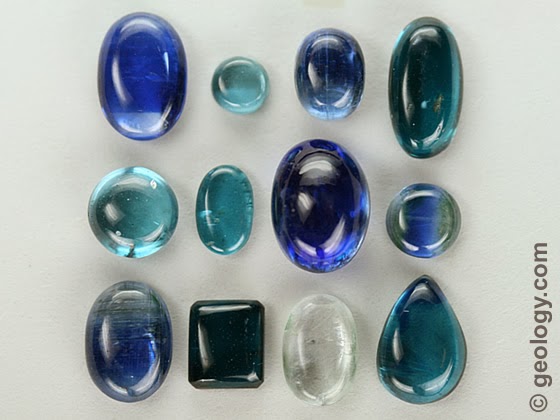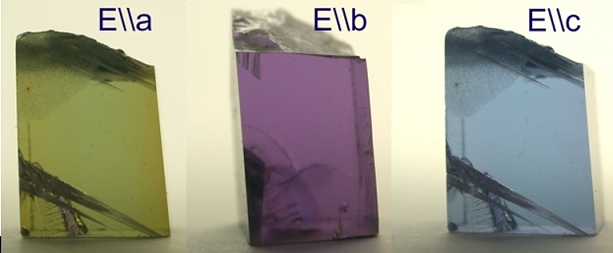The word comes from the Greek word pleo, meaning "more," and chroma, meaning "colors." More colors: right what it says on the tin. Pleochroism is the neat trick some minerals do where their color changes depending on the light and the angle you look at them. It can vary from slight changes in the saturation (from dark to light and vice versa) or it can be extreme changes in the the hue itself (from one color to another).
Pretty cool, right? So how does it work?
It comes down to light. (Which, for our purposes, is a wave.) Light waves oscillate, but they oscillate along multiple axes. As you change the angle of these minerals, you change which particular axis of oscillation hits the crystal structure, which changes the color you see. This is different from iridescence and schiller, which is a result of light reflection.
Remember, it's not as though anything about the stone's physical existence is changing as you rotate it; it's a change in the character of the light. (Since you don't see "things" as much as you see "light bouncing off of things.")
The effect is more striking in polarized light, in which the waves oscillate along the same axis. Those are what polarized lenses (like for cameras, or in certain sunglasses) do. They're not just tinted; they have a chemical coating that blocks out all but one of the planes of oscillation. The result is a drastic reduction in glare and richer, less washed-out colors.
Many gems exhibit some level of pleochroism, but the ones here are the most dramatic and (in my opinion) the loveliest. You should be able to see the color change in plain old unpolarized light in any of these—just change the angle you're viewing it at.
1. Iolite (Cordierite)
 |
| Iolite, courtesy Wikipedia |
(Mg,Fe)2Al4Si5O18
Color range: from deep blue/purple to almost clear.
I came to know this stone by the name of iolite, from the Greek word for "violet," but it's also known as cordierite, after the geologist Louis Cordier. Aside from its use in ornamentation, iolite (a synthetic version) is also used in catalytic converters to keep the ceramic from cracking due to heat.
2. Kunzite (pink spodumene)
| Kunzite, courtesy GIA.edu |
LiAl(SiO3)2
Color range: pink/light purple to clear.
Kunzite is named after mineralogist legend G. F. Kunz, who was the first to discover it. While he initially found it in the United States, kunzite is mined all over the world. The pink comes from traces of manganese (also found in rhodonite). Spodumene is an important source for lithium, which we use in rechargeable batteries and in some medications.
There is a green-to-clear variation of spodumene, called hiddenite, which is also pleochroic.
3. Kyanite
 |
| Kyanite, courtesy geology.com |
Al2SiO5
Color range: from dark, royal blue to sky blue to clear.
Not only is kyanite pleochroic, it's also anisotropic. That means it exhibits two levels of hardness perpendicular to each other, a trait very useful for its identification. Kyanite is often used in ceramics, particularly in dishware and in plumbing. The name derives from the Greek word kyanos, meaning "light blue".
Kyanite is a polymorph of andalusite and sillimanite, which are both pleochroic as well. Andalusite ranges from golden yellow to olive green, while sillimanite is clear to a light yellow-brown. In addition to being cut and used in jewelry, all three polymorphs are useful to geologists when trying to determine the heat-pressure history of larger host rocks.
4. Sphene (titanite)
 |
| Sphene (titanite), courtesy gemsociety.org |
CaTiSiO5
Color range: from reddish-brown to olive green to yellow.
Originally called sphene (from the Greek sphenos, meaning "wedge," in reference to its wedge-shaped crystal habit), the International Mineralogical Association "officially" changed it to titanite (due to its titanium content) in 1982. Books, collectors, and jewelers know it by both names. In addition to being cut and used in jewelry, titanite is also a source of titanium dioxide (TiO2), commonly used in white pigments and sunscreen because of its refractive abilities.
5. Tanzanite
 |
| Tanzanite, courtesy CalTech.edu |
Ca2Al3(SiO4)(Si2O7)O(OH)
Color range: from purple to blue to yellow-brown.
Tanzanite is named for Tanzania, the single source on Earth for this blue-purple variety of zoisite. The scientific name is actually blue zoisite, but Tiffany & Co. led the charge to call it tanzanite. They felt "blue zoisite" wasn't a very marketable name (it sounds like "blue suicide") and thought they'd capitalize on the gem's unique source. Tanzanite is not typically used outside of ornamentation and jewelry. However, it has proven to be so popular that it was added as an "official" birthstone for December; you may recognize its name from the updated Kansas jewelers' list. It should also be noted that commercial tanzanite is always heated to remove the yellow-brown coloration, so jewelry and cut stones only exhibit the purple-blue pleochroism.
Sometimes these gems are cut and set to show off their brilliant pleochroism and multitude of brilliant colors. Other times, cutters and jewelers try to minimize the effect as much as possible. Pleochroism occurs in many more minerals and gems than listed here—it's a trait often used in identifying minerals—but the effect is much more striking in some stones than in others.
Which one do you like the best?

Hello, I found you through SITS Girls; we're in the same Spring Fling group. :) What a cool thing to do...combine science with jewelry. As a former math teacher, I really like that. I love the gems you blogged about, but my fave is definitely sphene.
ReplyDeleteThanks! Math and science has always been a "thing" in my family. It even trickled down to the oddball humanities/liberal arts kid. ;)
DeleteSphene has some really unique and stunning colors, but I think it's been burdened with one of the uglier names in the gem world. Maybe that's why IMA tried to change its name...
Visiting from the SITS Spring Fling! You're right, who doesn't like pretty rocks? Such a pretty post!
ReplyDeleteI know! I could look act pictures of gems and minerals all day, pretty much, haha.
Delete